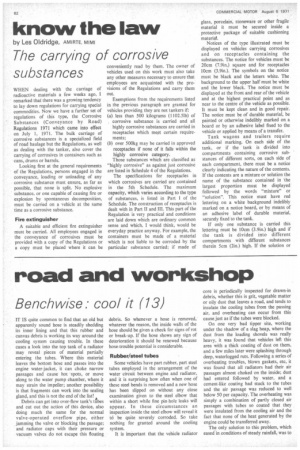know the law
Page 64

Page 65

If you've noticed an error in this article please click here to report it so we can fix it.
by Les Oldridge, AMIRTE. MIMI
The carrying of corrosive substances
WHEN dealing with the carriage of radioactive materials a few weeks ago, 1 remarked that there was a growing tendency to lay down regulations for carrying special commodities. Now we have a further set of regulations of this type, the Corrosive Substances (Conveyance by Road) Regulations 1971 which came into effect on July 1, 1971. The bulk carriage of corrosive substances is a specialized field of road haulage but the Regulations, as well as dealing with the tanker, also cover the carrying of corrosives in containers such as cans, drums or barrels.
Looking first at the general requirements of the 'Regulations, persons engaged in the conveyance, loading or unloading of any corrosive substance must ensure, as far as possible, that none is split. No explosive substance, or one capable of causing fire or explosion by spontaneous decomposition, must be carried on a vehicle at the same time as a corrosive substance.
Fire extinguisher A suitable and efficient fire extinguisher must be carried. All employees engaged in the conveyance of corrosives must be provided with a copy of the Regulations or a copy must be placed where it can be conveniently read by them. The owner of vehicles used on this work must also take any other measures necessary to ensure that employees are acquainted with the provisions of the Regulations and carry them out.
Exemptions from the requirements listed in the previous paragraph are granted for vehicles providing they are not tankers if: (a) less than 500 kilograms (1102.51b) of • corrosive substance is carried and all highly corrosive substances are carried in receptacles which me.et certain requirements; (b) over 500kg may be carried in approved receptacles if none of it falls within the highly corrosive category.
Those substances which are classified as "highly corrosive" as against just corrosive are listed in Schedule 4 of the Regulations.
The specifications for receptacles in which corrosives are carried are contained in the 5th Schedule. The maximum capacity, which varies according to the type of substances, is listed in Part I of the Schedule. The construction of receptacles is dealt with in Part II and III. This part of the Regulation is very practical and conditions are laid down which are ordinary common sense and which, I would think, would be everyday practice anyway. For example, the containers must be made of a material which is not liable to be corroded by the particular substance carried; if made of
glass, porcelain, stoneware or other fragile material it must be secured inside a protective package of suitable cushioning material.
Notices of the type illustrated must be displayed on vehicles carrying corrosives and on receptacles containing the substances. The notice for vehicles must be 20cm (7.9in.) square and for receptacles 10cm (3.91n.). The symbols on the notice must be black and the letters white. The background to the upper half must be white and the lower black. The notice must be displayed at the front and rear of the vehicle and at the highest practical point and as near to the centre of the vehicle as possible. It must be kept clean and in good repair. The notice must be of durable material, be painted or otherwise indelibly marked on a board or by an adhesive label fixed to the vehicle or applied by means of a transfer.
Tank wagons and trailers require additional marking. On each side of the tank, or if the tank is divided into compartments containing corrosive substances of different sorts, on each side of each compartment, there must be a notice clearly indicating the nature of the contents. If the contents are a mixture or solution the name of the substance contained in the largest proportion must be displayed followed by the words "mixture" or "solution". This notice must have red lettering on a white background indelibly marked on a notice board, or by means of an adhesive label of durable material, securely fixed to the tank.
If only one substance is carried this lettering must be 10cm (3.9in.) high and if the tank is divided into different compartments with different substances therein 5cm (2in.) high. If the solution or mixture is destined for disposal as waste then the notice may read "Disposal Waste" instead of being labelled as outlined above.
Containers must be similarly marked although no dimensions are given for the words "Solution"Mixture" or -Disposal Waste". As stated earlier they must carry the smaller square notice.
Containers The provisions concerning the marking of containers need not be complied with if the total quantity of corrosive substance contained in it does not exceed one kilogram (2.21b) and in this connection in calculating the quantity there is no need to count any of the substance which has been absorbed by the plates of a battery.
There are minor exemptions for vehicles brought temporarily into Great Britain by visitors and there are special exemptions for corrosive substances conveyed in a battery. These latter exemptions are important, particularly where electrically propelled vehicles are concerned. Exemption is granted to most of the Regulations if the battery: (a) is used in connection with the operation of a vehicle or any apparatus forming part of a vehicle; or (b) contains sulphuric acid in aqueous solution and no other corrosive substance; or (c) contains potassium hydroxide in aqueous solution and no other corrosive substance and: (i) it is closed so as to prevent leakage; (ii) there is adequate protection against short circuits; (iii) the cells are of steel or plastics material affording the same degree of protection as afforded by steel.




























































































































